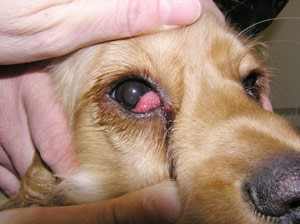Overview and Risks
Has your pooch had irritated eyes lately? The cause could corneal ulceration. The clear surface of the eye is called the cornea, and because it is the outermost layer of the eye, it is more prone to injury than the rest of the eye. Injuries to the cornea have many causes:
- Scratches
- Ingrown eyelashes
- Foreign material in the eye
- Chemicals
- Heat or smoke
- Infection
- Decreased tear production
While an injury to the eye is the most common cause of a corneal ulcer in dogs, certain breeds are prone to a condition known as entropion, in which the eyelid rolls inwards rather than outwards, causing the eyelashes to irritate the cornea. While all dogs are at risk for a corneal ulceration, breeds with prominent eyes are at greater risk. These breeds include:
- Pug
- Boston Terrier
- Pekingese
- Boxer
- Bulldog
- Shih Tzu
- Other brachycephalic breeds (those breeds with “smooshed in” noses or flat faces).
Symptoms
Ulcers of the eye are very painful and your dog may paw at his or her eye. Additional signs can include:
- Increased tearing
- Colored discharge from the eye
- A cloudiness in the eye
- Redness of the eye
- Squinting
 Diagnosis and Treatment
Diagnosis and Treatment
Besides causing your pet a lot of pain, an untreated corneal ulcer can cause blindness. Your veterinarian will want to examine your pooch’s eye(s) very carefully to determine if there is an ulcer of the eye. The exam may include the following:
- The application of a special fluorescent stain to the eye which, when illuminated with a special light, indicates if the eye is ulcerated.
- A test to measure the production of tears
- Special tests of eye discharge to identify whether the cause is bacterial or viral
- If your veterinarian determines that your dog has an ulcer of the eye, the following treatment may be recommended:
- Treatment of the underlying cause if necessary
- An antibiotic eye ointment or drop to treat or prevent infection
- Optical pain medication
- An Elizabethan collar to prevent rubbing or scratching
- Other medications depending on the severity of the ulcer
- For non-healing, chronic ulcers surgery or referral to a veterinary ophthalmologist may be necessary
It is critical that you administer all the medication your veterinarian prescribes for your canine friend.
Prevention
Because there are so many different causes of an ulceration of the eye, there is no single preventive method that works for every situation. To help reduce your furry friend’s risk of eye problems, check his or her eyes daily for any obvious signs of irritation such as redness or tearing. Most importantly, contact your veterinarian if you suspect your dog’s eyes look irritated or inflamed.
If you have any questions or concerns, you should always visit or call your veterinarian – they are your best resource to ensure the health and well-being of your pets.
